Object of the study: the Mdewakanton Dakota / Sioux Indian Tribe of Red Wing
- Native American tribe and its special features.
- Media and cultural communication challenges of the tribe.
- Cultural identity and value orientations of Indians.
- Verbal Communication Characteristics of the tribe.
- Nonverbal communication characteristics and specific features.
- Conflict styles, management and the role of media.
- The representation of the tribe in the media.
As the object of study, the tribe of Indians living on the territory of modern America is represented. Various characteristics of this tribe are of interest for study. Communicative and cultural features, as well as management traits are the attributes of the research conducted for the determination of the tribe’s primary peculiarities.

Ethnocentrism and Its Reflection
- Ethnocentrism is a set of stereotypes about others’ culture.
- The lack of knowledge affects the emergence of stereotypes (Jenifer & Raman, 2015).
- Key features are moral character and intellectual capacity.
- The tribe feels the influence of ethnocentrism.
- Prejudices associated with the historical image of Native Americans.
- Racist behavior as the result of ethnocentrism.
- The attraction of additional attention to the tribe.
Ethnocentrism is one of the signs characterizing the attitude of people to the Native Americans and in particular to the Mdewakanton tribe. The key reason for this phenomenon is the prejudices caused by the historical image of Indians. Different opinions and rumors stick excessive attention to the studied population and their way of life.
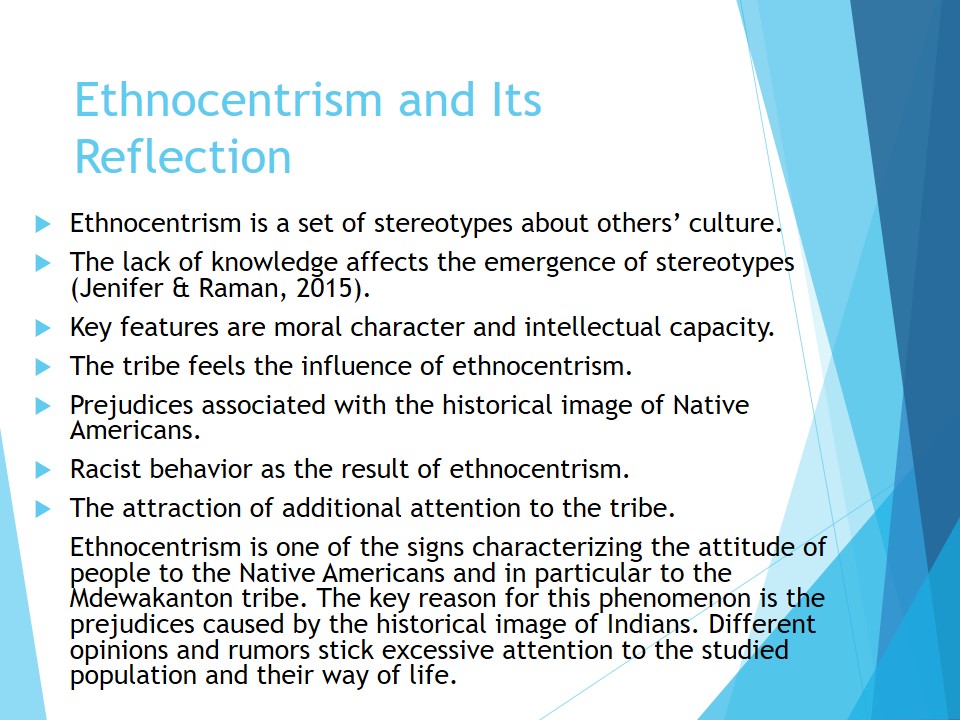
Media Challenges
- Images of typical features inherent to Indians.
- The manner of insufficiently deep demonstration of tribal traits
- The perception of the Indian way of life as uncivilized.
- Attempts to convey a new picture of the world.
- The controversial mascot of the local baseball team.
- The image of warriors and bloodthirsty combatants.
- The ignorance of history and false facts.
Displaying the Mdewakanton tribe in the media is quite often controversial and based on prejudices. The way of life of Indians is sometimes regarded as uncivilized, as a result of which the society often has misconceptions about the culture of the tribe. Stereotypes about the militancy of local people have become the reason for the prevailing opinion about their bloodthirstiness.
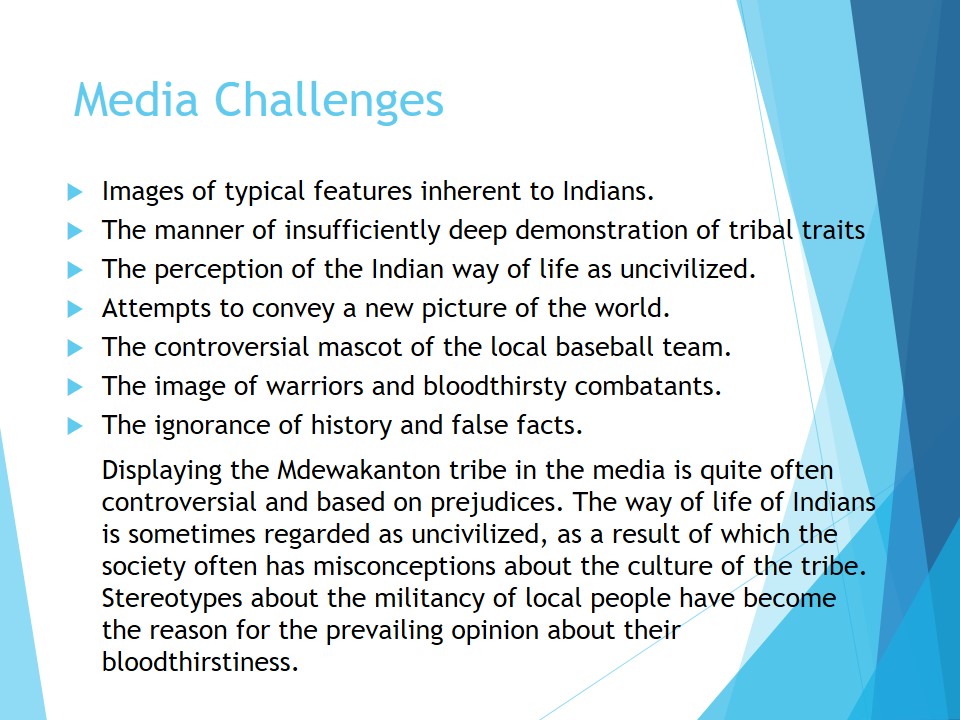
Prejudices and Beliefs
- All attention is paid to hunting.
- White people are eternal blood enemies.
- The absence of civilization, barbarism and chaos.
- Almost a complete lack of a verbal communication.
- Hatred people outside the reservation’s borders.
- A human life is nothing, memory is significant.

Possible Ways to Solve the Problem
- A more in-depth study of the tribal society.
- The study of the cultural characteristics of Indians.
- The absence of racist and prejudiced perceptions.
- Attention to the traditions of Indians.
- Bringing attention to the native people’s lives.
- Avoiding the theme of bloodthirstiness and militancy.
In order to avoid ethnocentrism and prejudice, it is necessary to study the traditions of the tribe more deeply. A possible reason for stereotypes is obsolete judgments about the way of life of Indians. Modern ideas about the traditions of the tribe are based only on the history of the life of this community, and not on actual data.
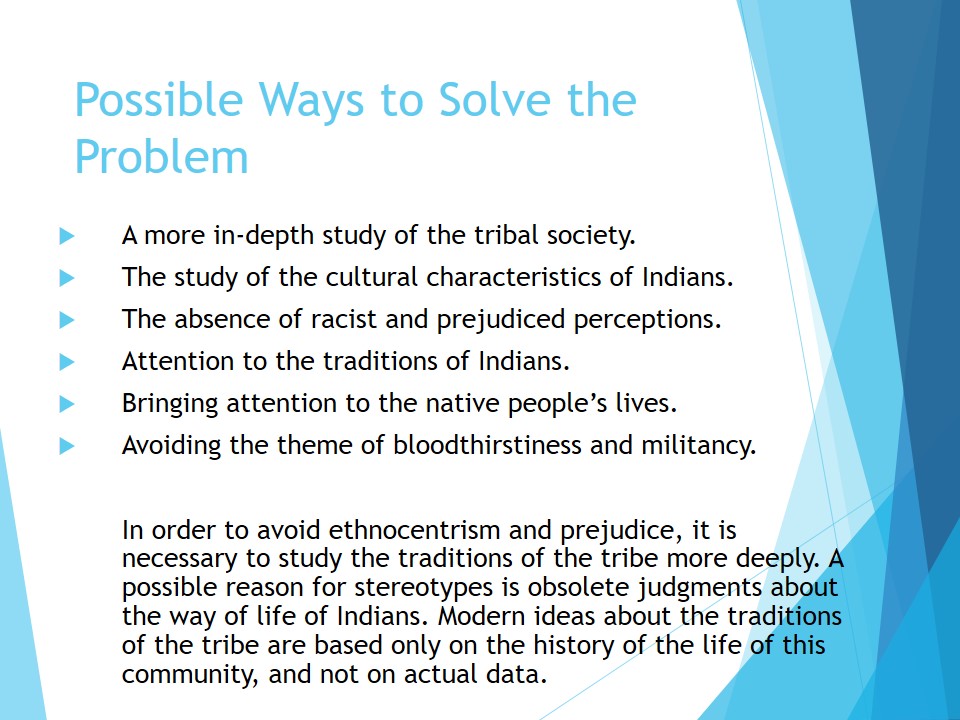
Value Orientations
- Adaptation to the new way of life.
- Creation of natural areas and care for animals.
- The preservation of cultural heritage and moral values.
- Readiness to defend the territory and culture.
- A deep involvement in American gambling business.
- Festivals and concerts dedicated to the tribe’s history.
- The memory of ancestors and wisdom in solving problems.
The Indians of the Mdewakanton tribe are distinguished by a close connection with the past and the memory of their ancestors. These people respect wisdom in judgments, as well as the love of nature and the world around them. One of the interests of this community is gaming business (Canby, 2014). Regular concerts and festivals of folk art attract tourists to the community of the native people.
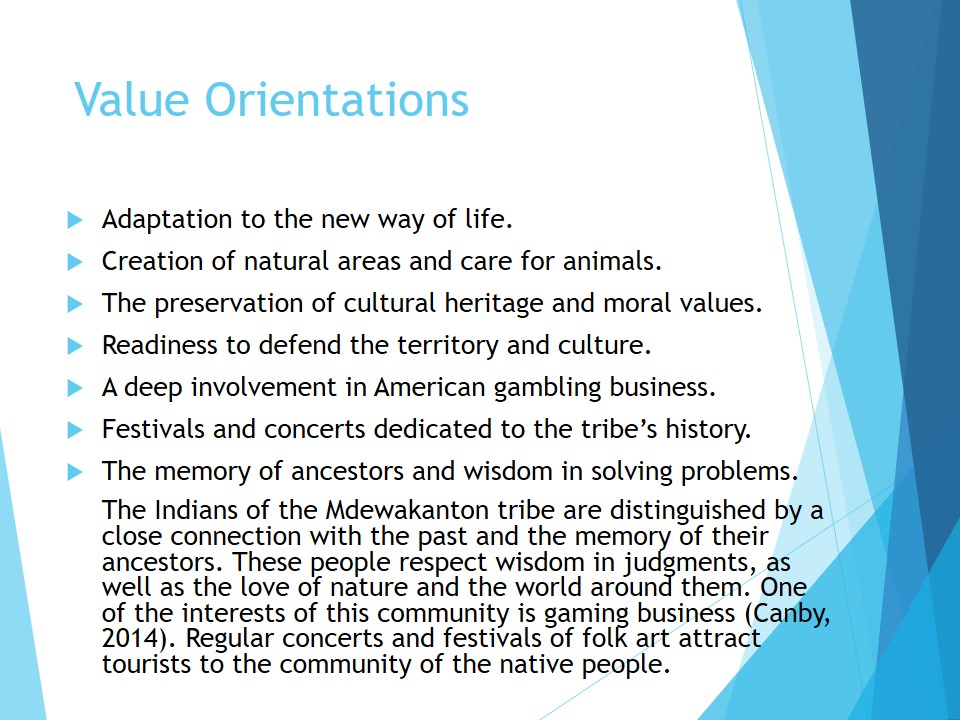
Popularization of Culture
The attraction of the inhabitants of large cities to the culture of Indians is an indispensable attribute of the native’s lifestyle. Constant festivals and master classes conducted by the local people serve as a good means of popularizing their art, as well as enriching the treasury of the reservation.
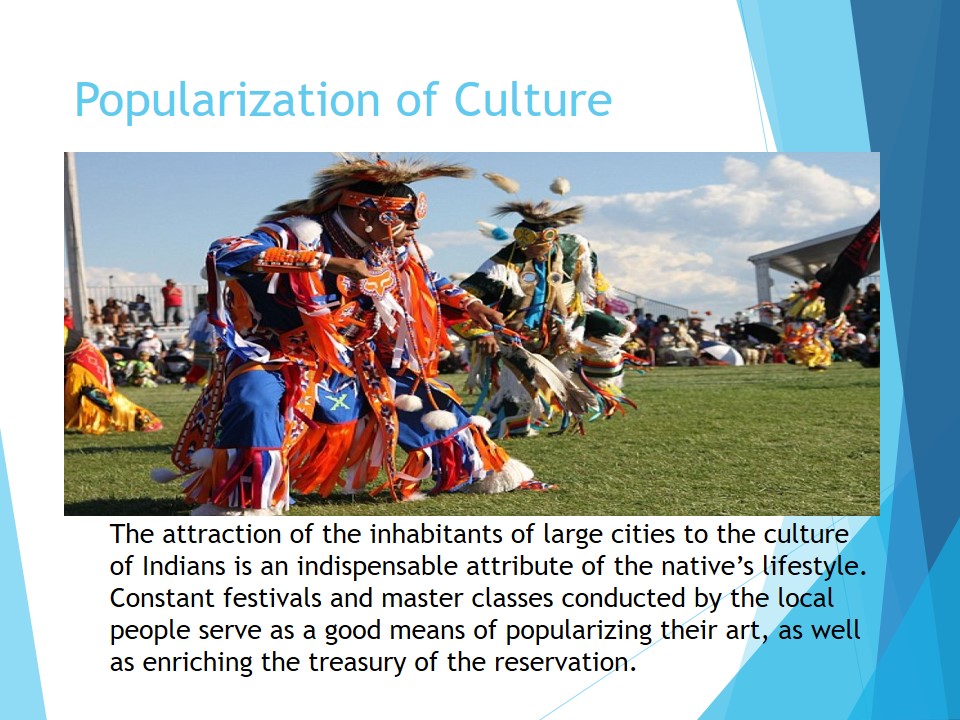
Cultural Identity and Type of Community
- A collectivist type of culture as a norm.
- A monochronic type of behavior of the tribe’s members.
- Uncertainty avoidance as the characteristic of the society.
- The relationships of dependence among the native people.
- The maintenance of order and existing beliefs.
- Directness and sincerity towards the outside world.
- Disloyalty to the damage of the environment.
The characteristic features of the cultural organization of Indians are the type of their behavior and propensity to support the ideas of the tribe. The preservation of national values is one of the main goals. Sincerity and simplicity in judgments, as well as intolerance to environmental damage make this cultural group unique and distinctive.
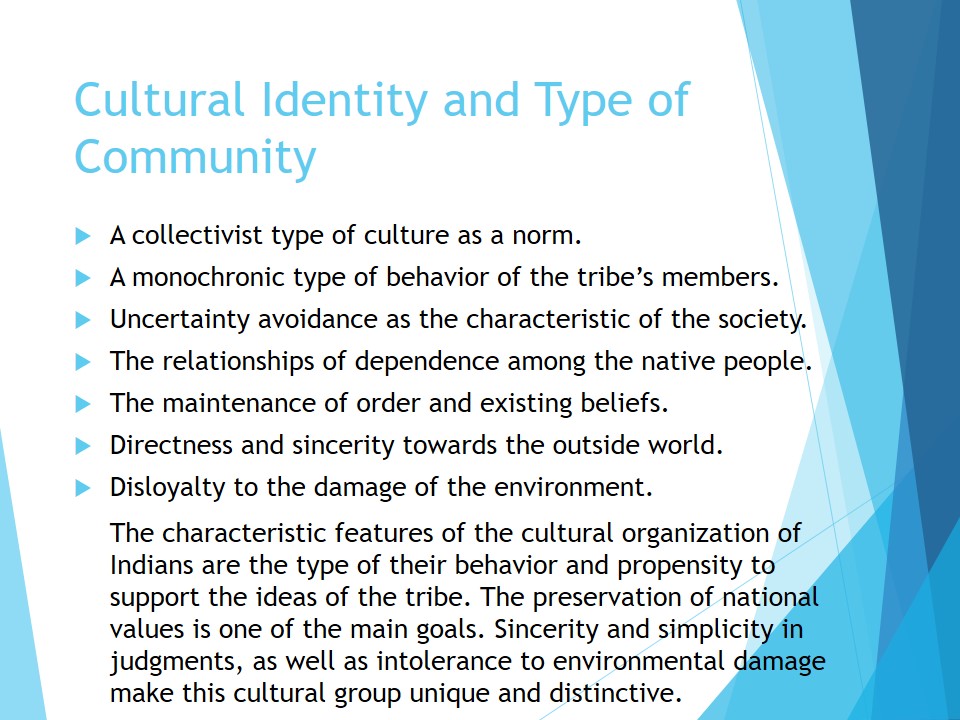
Verbal Communication Characteristics
- A lot of unique expressions and interpretations.
- English as a common language in the tribe.
- Brevity in short communicative utterances of Indians.
- Relative simplicity of the native people’s language.
- The absence of long and extended sentences (Elbert, 2016).
- The topics are significant for the people themselves.
- Constant reference to ancestors’ knowledge and experience.
As many researchers note, the language of the Mdewakanton tribe does not have the complexity of constructions or the depth of phrases. Nevertheless, the local people understand one another and use only those turns that are important to them. Particular importance in their language is the theme of nature and the names of the world’s objects that surround Indians.
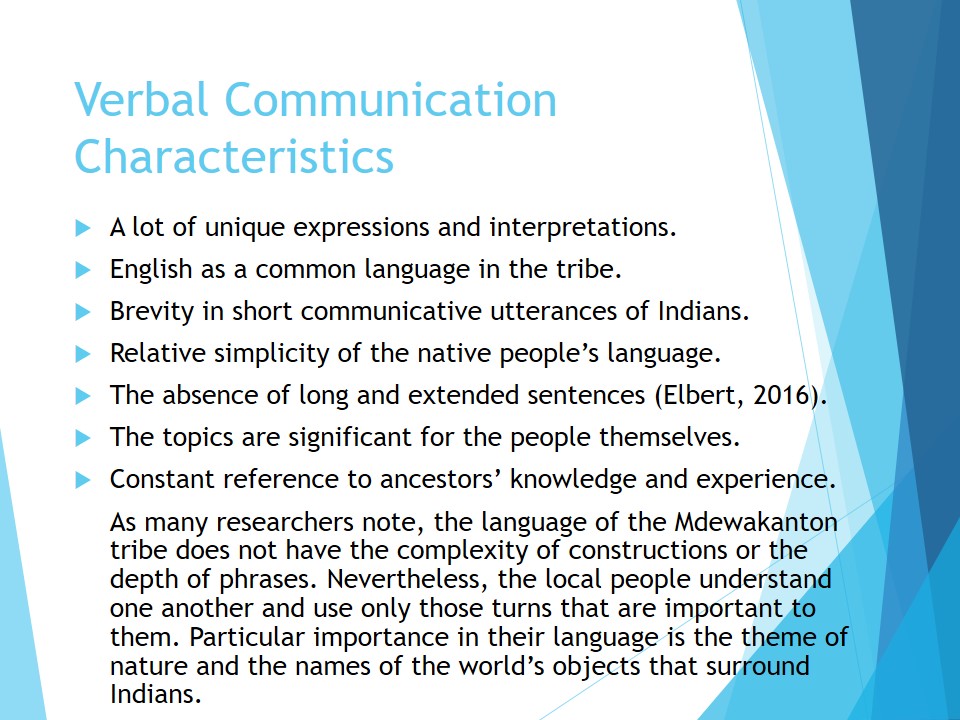
Influence of Nature on the Vocabulary
- The use of the numerous terms of flora and fauna.
- Lexical structures that convey meanings and descriptions.
- The words that have survived for centuries.
- The transition to English as a basic language.
- Idioms and set expressions including natural features.
- The attitude to nature and its objects is sacred.
- Attempts to simplify the language and its units.
Despite the fact that the English language is dominant among the people of the Mdewakanton tribe, some phrases and constructions are still preserved. Indians pay great attention to the nature and respect any of its manifestations. The natives have many words to denote some elements of the nature, emphasizing the meaning but not external signs.
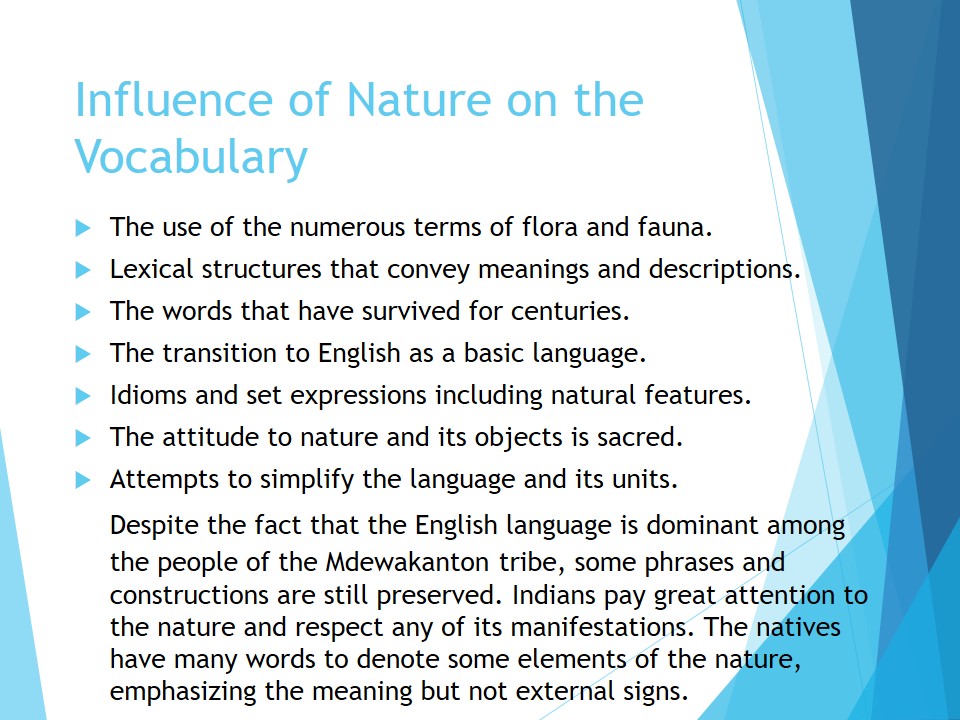
Peculiarities of the Language System
- The love of nature through language since childhood.
- Frequent reference to obsolete and archaic constructions.
- The absence of borrowing from other world’s languages.
- Respect for the traditions of the language despite the popularization of English.
- The brevity and even stinginess of lexical structures.
- The topic of battles is manifested in the language.
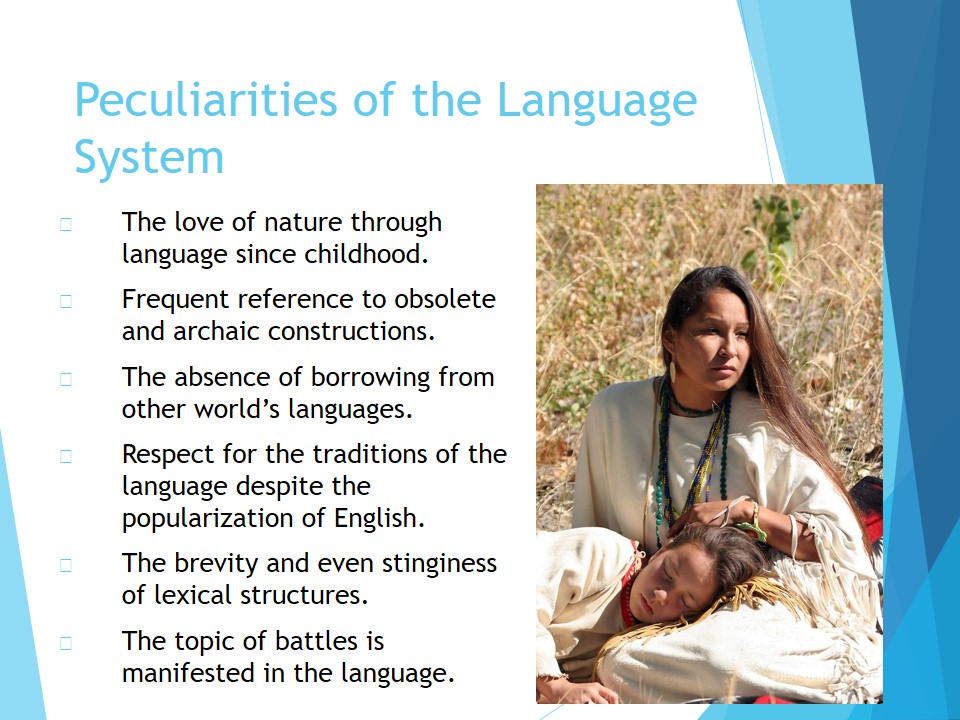
Nonverbal Communication Characteristics
- The similarity of intonations to demonstrate a threat.
- Similar signs of appreciation and approval.
- Indians smile to show a friendly attitude.
- An active use of hand and fist gestures (Bales, 2013).
- Differences in the signs of greeting, farewell and gratitude.
- A rather meager manifestation of emotions.
- The absence of a hidden meaning in behavior.
Despite the differences in cultures, Indians have quite a lot in common comparing to ordinary people. The members of the Mdewakanton community use the same gestures as people outside the reservation. Contemporary natives have some special signs, in particular, these are hand gestures. The manner of their behavior is distinguished by the stinginess of emotions and the absence of a hidden meaning in the manifestation of feelings.
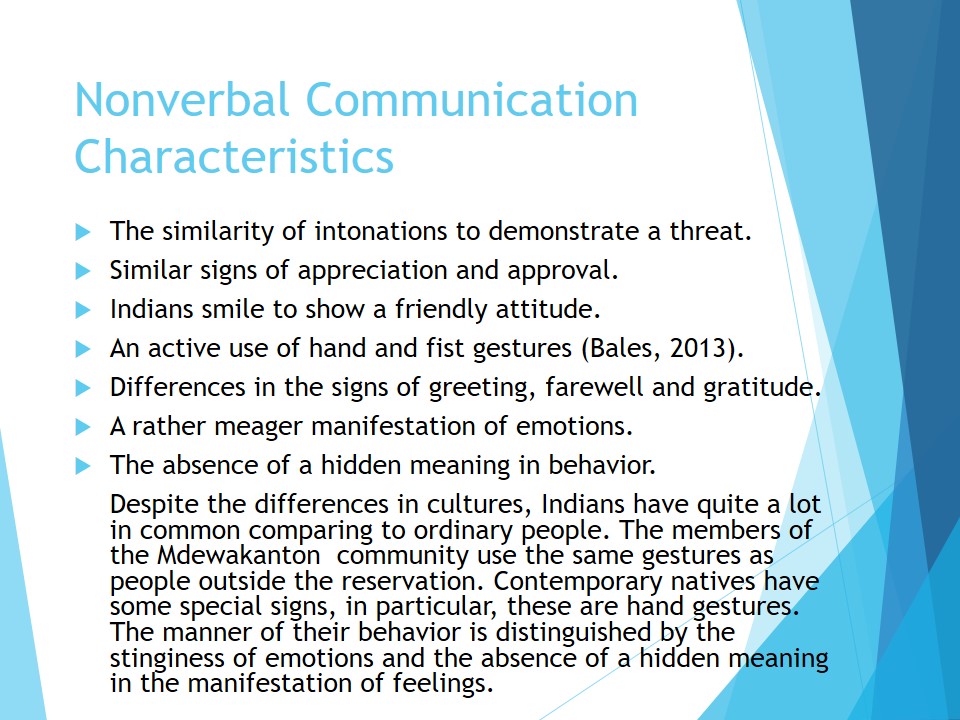
Approach to Nonverbal Communication
- Specificity in expressing emotions and feelings.
- The absence of aspirations for persuasion.
- Unwillingness to impose a personal opinion.
- Propensity to listen but not talk.
- A mean facial expression and rare intonational changes.
- The absence of touch as a feelings manifestation.
The Indians of the Mdewakanton tribe, as it is known, rarely show vivid emotions and do not manifest their enthusiasm or frustration as other people do. They do not use those nonverbal communication techniques that are typical for other nations. The interactions of Indians are not characterized by touches, embraces, and other manifestations of feelings.
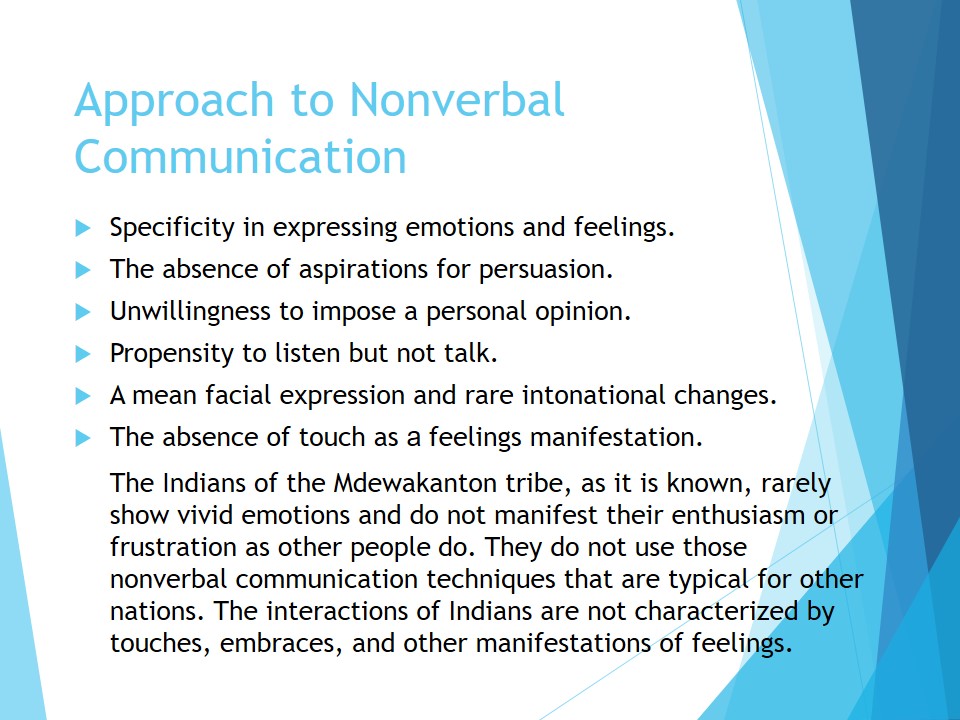
Stereotypes of Nonverbal Forms of Communication
- A raised hand as a typical greeting gesture.
- The stinginess of words and emotional expressions.
- The avoidance of a close contact.
- A long study of an interlocutor’s behavior.
- Communication with relatives with a minimum of words.
- Inexpressive speech and facial expressions during the conversation.
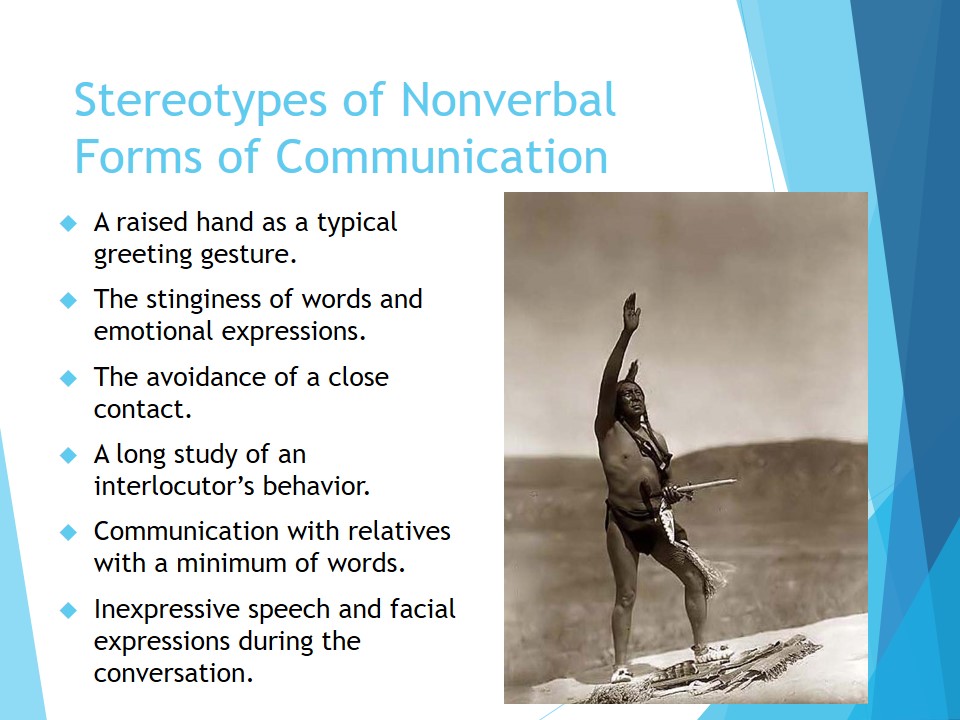
Conflict Styles
- Conflict is often accompanied by cooperation and unity (Yang, Ryan, & Zhang, 2013).
- Group members can influence a conflict.
- A conflict should be allowed to unfold.
- Conflict resolution helps to unite a team.
- Division into separate groups adversely affects productivity.
- Any conflict can be reduced by a collaborative work.
Conflict situations in the team arise quite often. It is important to try to avoid such difficulties; however, if they arise, no one should be afraid to solve them by joint efforts. The division of the collective into separate groups will just worsen the situation and will not allow achieving positive results of work. A collaborative work is one of the key methods that helps to adjust the situation in the team.
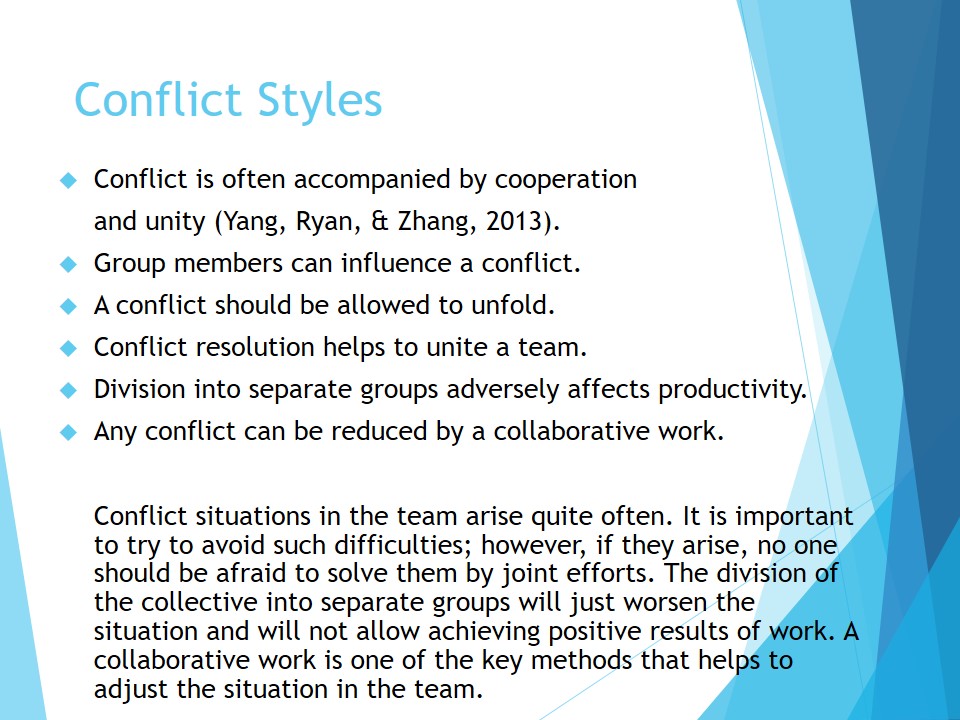
Proper Management Strategies
- Organization of well-coordinated work despite the conflict.
- Personal benefits in the work process are unacceptable.
- Communication in an official style, without anger.
- Observance of ethical standards of behavior is necessary.
- Using a personal example as a means to work successfully.
- The background diversity is one of conflict reasons.
- The avoidance of subjective assessment of employees’ work.
One of the important moments during the conflict in the team is the position of the leadership in relation to the situation. Certainly, it is important to show that the solution of an issue through quarrels is unacceptable. The observance of moral and ethical norms is also necessary. The subjective evaluation of employees’ work should be avoided as it is better to ask the team for help and to demonstrate personal willingness to work.
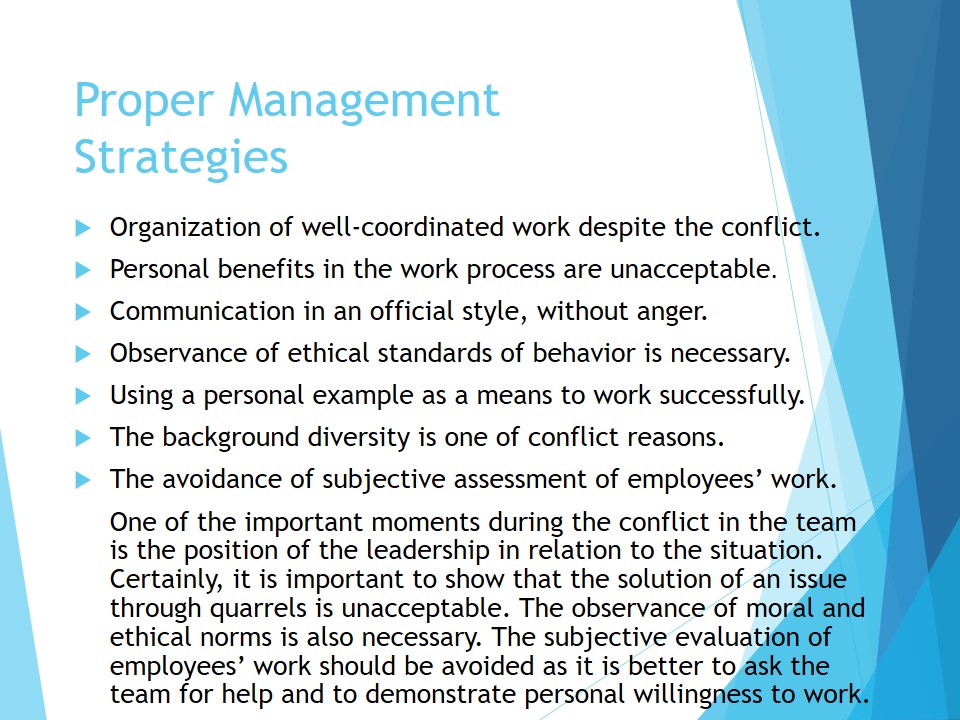
Role of Mass Media in Conflicts
- The knowledge obtained limits the ideas of people.
- Stereotypes in the media influence a personal opinion.
- An image formation may be the reason for a conflict.
- Different world views should not be the reason for disputes.
- Voting against another person is a tendency.
- A traditional approach to work is considered conservative.
- Ethical biases towards members should be avoided.
The role of the media in the emergence of conflicts is sometimes obvious. Traditional ideas about the characteristics of the people of other cultures should not affect the perception of a particular situation. Voting has become an integral part of work, and sometimes employees use it too often. Different points of view should not become the basis for conflict situations.
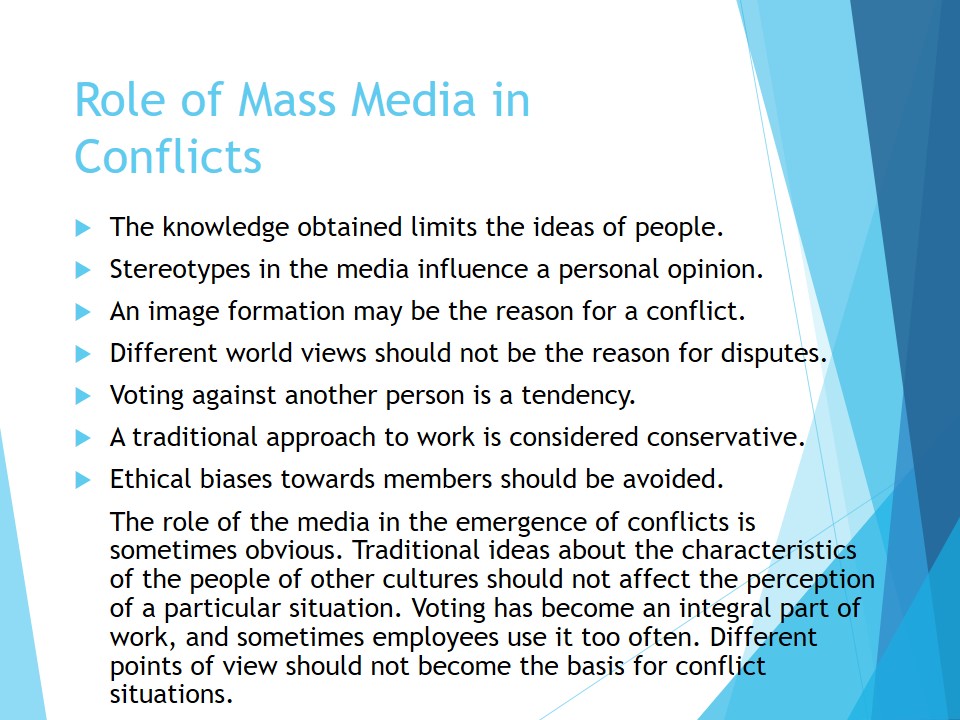
Consultation in Conflict Resolution
- The demonstration of productivity despite a conflict
- Overcoming a problem helps to develop an efficient strategy.
- Cooperation in small groups reduces the chances of success.
- The formation of alliances is unacceptable (Yang et al., 2013).
- An intergroup contact allows eliminating possible prejudices.
- No one should spread any influence on colleagues.
- Personal benefits are lower than the group’s ones.
Consultation is quite important in the process of work and in case of a conflict situation. It is important to remember that community interests are more important than personal benefits. Alliances in small groups inevitably lead to the split of the collective. Any influence on colleagues should be avoided; otherwise, a conflict situation will only worsen.

The Reflection of the Studied Culture
- Ethnocentrism is observed in studying the Mdewakanton tribe.
- Prejudices and beliefs concerning the community still exist.
- The role of mass media is obvious and significant.
- The nonverbal characteristics of Indians are similar.
- The nature and the memory of ancestors prevail.
- Collaborative work helps to reduce a conflict.
- An intergroup contact allows eliminating possible problems.
The culture of an Indian community is distinguished by its identity and connection with the past. The influence of the media on the formation of prejudices is quite evident. The nonverbal features of the communication in the tribe are not so developed as among other people. The language of this group of people is characterized by the brevity and simplicity of lexical constructions.

Importance of the Research
- The attraction of attention to the studied culture.
- The minimization of negative effects of culture shock.
- The avoidance of prejudices regarding the Indians’ way of life.
- The comparison of tribal and traditional communication.
- The determination of the role of the media in self-awareness.
- The description of people’s values in the reservation
- The methods of conflict resolution and management strategies.
The conducted research allows studying the features of culture of the Indian Mdewakanton tribe. With the help of a detailed review of the verbal and non-verbal characteristics of this community, it is possible to conclude about the type of communication that is typical for this group. Also, the study helps to determine the role of the media and its negative consequences on the consciousness of people in the form of ethnocentrism. Any prejudices may be avoided.
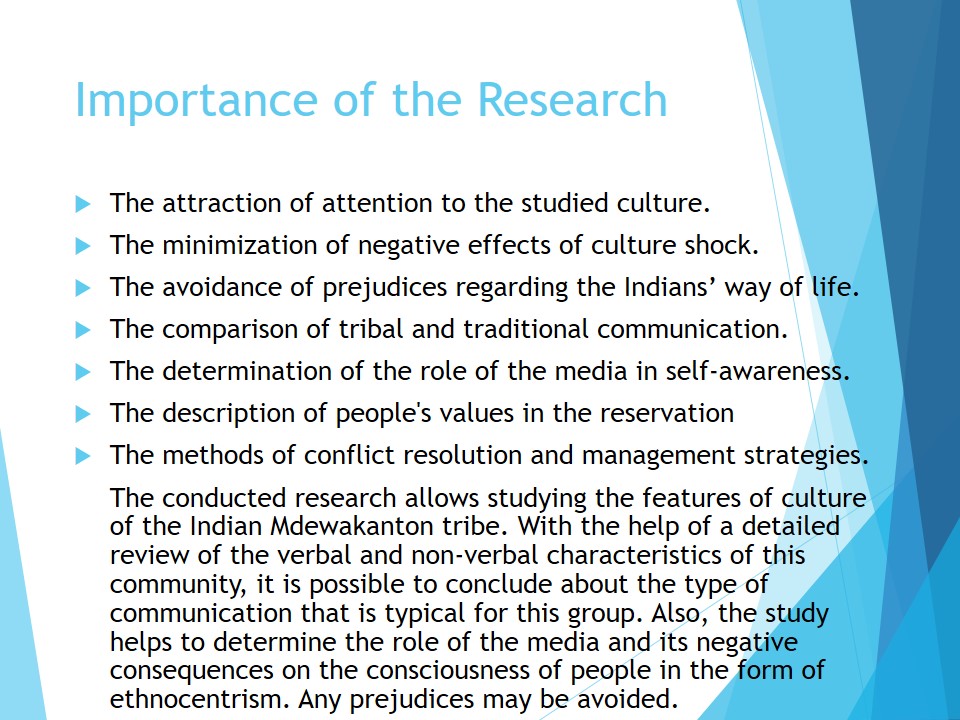
References
Bales, R. A. (2013). AmericanIndianworldviews, riskperceptionsanddisasterplanning: Anexploratorystudy. Web.
Canby, W. C. (2014). American Indian law in a nutshell (6th ed.). St. Paul, MN: West Academic Publishing.
Elbert, L. (2016). Dakota language: Past, present and future. Web.
Jenifer, R. D., & Raman, G. P. (2015). Cross-cultural communication barriers in the workplace. International Journal of Management, 6(1), 348-351.
Yang, J., Ryan, C., & Zhang, L. (2013). Social conflict in communities impacted by tourism. Tourism Management, 35(1), 82-93.